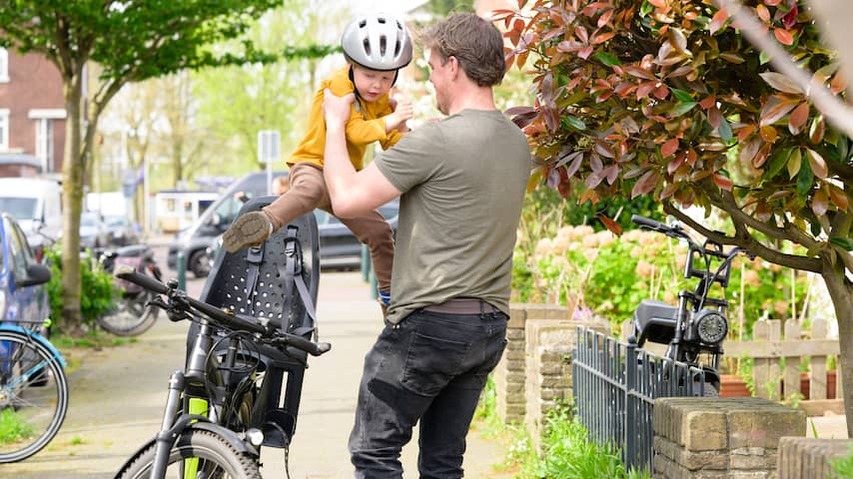
Just like the first smile, tooth, and bite, the first bike ride with a child is a milestone for many parents. But it’s also nerve-wracking to take your toddler on a wobbly bike. Here’s how to reduce the risk of accidents.
A child who cannot yet ride a bike can be transported by cargo bike, in a bicycle trailer that you pull behind the bike, in a Maxi-Cosi holder that you mount on the luggage carrier, or, of course, in a front or rear seat. The risk is greatest with the latter option, says knowledge center KinderveiligheidNL. Every day, as many as nine children end up in the emergency room because a foot gets caught in the spokes.
The foot between the spokes is number one, but can be prevented, says Kees Bakker. He is a consumer information officer at the Fietsersbond (Cyclists’ Union) and specialized in child seats. “Number two is injury from falling bikes with a child already in it. A child is in a front or rear seat, the parent walks away for a moment to grab something, and the bike falls over.”
Another unsafe method of transport that causes many accidents is the extra saddle on the bar, between your own saddle and the handlebars. If you ride over a bump or curb, a child’s leg can easily fly into the front wheel. That’s scary, but the good news is that with care and attention, you can prevent many accidents.
Straps over the foot, windscreens for the front seat, seatbelts, an extra chain to secure the bicycle trailer extra tightly to your bike: these protective accessories are there for a reason. So really use them, says Bakker. “Of course it’s a hassle, adjusting those seatbelts again when they’re wearing a thick coat. But do it.”
Make Sure Your Equipment is in Order
These parts can wear out over time, explains Marlous de Wit from child seat brand Bobike. “The plastic of the seat also suffers from UV radiation and temperature fluctuations. It is important to regularly check (or have checked) the seat and replace it in time. The recommended lifespan of a bicycle seat is approximately five years.”
If you buy a seat via Marktplaats (Dutch equivalent of Craigslist), it is not always clear whether all protective parts are included. Moreover, you have to assemble it yourself, which is not easy for everyone. “Our advice is to buy a new one and have it installed by the bicycle repair shop,” says Bakker.
Also have the material checked regularly – both seats, bicycle trailers, and cargo bikes, says De Wit. “As with any mechanical product, wear or an unexpected break can occur, especially with intensive use or over time.” Always check that the tires, axles, mounting points, and frame are in good condition before you hit the road.
Adjust your route and speed to the age
Babies can only be placed in a bicycle seat when they can sit up well. This means that they can come from a lying position to a sitting position on their own. Then they can come along in a bicycle seat on the handlebars of your bike. On average, children can do this when they are between nine and twelve months old.
Don’t go too far on those first few rides, says Bakker. “If they fall asleep, you yourself can cycle less safely, because you have to support their head.” Also pay attention to vibrations, and keep your tire pressure low, so you don’t bounce up curbs. A helmet is not mandatory, but of course it increases the safety of your baby.”
Practice with Something in Your Bike Seat Before You Take the Baby
It’s not difficult, says De Wit. But it takes some getting used to getting on, cycling, and getting off with children in the seat. “Front seats shift the weight to the front of the bike, which affects steering. This can make steering a bit heavier and requires good control of balance, especially at low speeds.”
A child in the rear seat shifts the center of gravity to the rear, which can cause a wobbly feeling, especially if the child is moving. A good distribution of the cyclist’s body weight helps to maintain stability, but you can also place a crate on the front of the bike for more balance.” Practice is useful, say both cycling experts.
“Take a few test rides without a child in it to get used to the extra weight and the change in balance. It takes some practice to slow down and stop safely and controlled, especially with a child in a rear seat that raises the center of gravity.” Bakker: “You suddenly have a little less space between the saddle and the handlebars, so practicing with a doll in the seat is quite a good idea.”